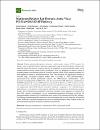Marjoram Relaxes Rat Thoracic Aorta Via a PI3-K/eNOS/cGMP Pathway.

View/
Date
2019-06-01Author
Badran, AdnanBaydoun, Elias
Samaha, Ali
Pintus, Gianfranco
Mesmar, Joelle
Iratni, Rabah
Issa, Khodr
Eid, Ali H
...show more authors ...show less authors
Metadata
Show full item recordAbstract
Despite pharmacotherapeutic advances, cardiovascular disease (CVD) remains the primary cause of global mortality. Alternative approaches, such as herbal medicine, continue to be sought to reduce this burden. is recognized for many medicinal values, yet its vasculoprotective effects remain poorly investigated. Here, we subjected rat thoracic aortae to increasing doses of an ethanolic extract of (OME). OME induced relaxation in a dose-dependent manner in endothelium-intact rings. This relaxation was significantly blunted in denuded rings. N(ω)-nitro-l-arginine methyl ester (L-NAME) or 1H-[1,2,4]oxadiazolo[4,3,-a]quinoxalin-1-one (ODQ) significantly reduced the OME-induced vasorelaxation. Cyclic guanosine monophosphate (cGMP) levels were also increased by OME. Moreover, wortmannin or LY294002 significantly reduced OME-induced vasorelaxation. Blockers of ATP-sensitive or Ca2+-activated potassium channels such as glibenclamide or tetraethylamonium (TEA), respectively, did not significantly affect OME-induced relaxation. Similarly, verapamil, a Ca channel blocker, indomethacin, a non-selective cyclooxygenase inhibitor, and pyrilamine, a H1 histamine receptor blocker, did not significantly modulate the observed relaxation. Taken together, our results show that OME induces vasorelaxation via an endothelium-dependent mechanism involving the phosphoinositide 3-kinase (PI3-K)/ endothelial nitric oxide (NO) synthase (eNOS)/cGMP pathway. Our findings further support the medicinal value of marjoram and provide a basis for its beneficial intake. Although consuming marjoram may have an antihypertensive effect, further studies are needed to better determine its effects in different vascular beds.
Collections
- Biomedical Sciences [847 items ]

